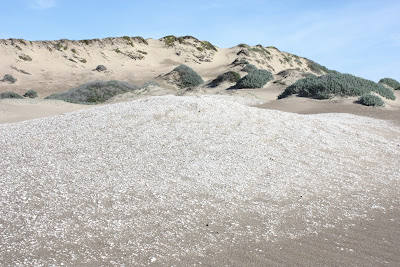 The weather here has recently varied between warm spring like weather and cold stormy weather that has dusted the nearby hills with snow twice recently (see the photo in the column to the right). Spring migrants have been arriving such as many of the swallow species. A young male Bullock's Oriole was in the neighborhood last week, but it is unclear if this was a wintering bird, an early migrant, or? A pair of Allen's Hummingbirds are likely nesting at the end of the street and I will post a photo if I can find their nest. The waterfowl and shorebirds are still around, but they are starting to go down in number and the White Pelicans are all or mostly gone. I can still find between 40 and 50 species on a 30 minute walk in the morning, so I can't complain.
The weather here has recently varied between warm spring like weather and cold stormy weather that has dusted the nearby hills with snow twice recently (see the photo in the column to the right). Spring migrants have been arriving such as many of the swallow species. A young male Bullock's Oriole was in the neighborhood last week, but it is unclear if this was a wintering bird, an early migrant, or? A pair of Allen's Hummingbirds are likely nesting at the end of the street and I will post a photo if I can find their nest. The waterfowl and shorebirds are still around, but they are starting to go down in number and the White Pelicans are all or mostly gone. I can still find between 40 and 50 species on a 30 minute walk in the morning, so I can't complain.I saw a banded Brant on the edge of the bay March 19, with a greenish (apparently faded blue) band on its left leg which read "2TV". I checked with John Roser, who has monitored Brants in the past, and he found out that this bird was banded in the summer of 1995 near Liverpool Bay on the Beaufort Sea, Northwest Territories. So, it is over 15 years old. As it was starting to rain, I took the banding code as an omen and went home to watch "March Madness" (college basketball playoffs) on the television! College basketball helps to keep my mind off birding when it is raining. The rain also provided an opportunity to update this blog.

Despite the rainy weather, birds continue to migrate through this area. The Western Kingbird (left) came through my neighborhood on March 20 and stayed a couple of day before moving on. They nest a few miles inland from where I live on the coast.
On March 25, orioles pushed through the area. Three bright adult male Bullock's Orioles stopped at the end of my street before moving on. One of our local breeding Hooded Orioles (adult male) returned to his nesting palm tree down the street from my house on the same date. I could suddenly hear and see a large influx of Selasaphorus hummingbirds in the neighborhood starting on the 22nd, but I didn't see a male well enough to ID it till the 27th and it was clearly a Rufous with a solid rusty back. Allen's Hummers had been around for over a month, so I had figured that this recent push was Rufous Hummers.
 On April 5, the weather had been mostly warm for a few days, and the migration continued, albeit slowly. While walking along the bay, in the morning, a grosbeak called out from a nearby oak. Sounding like a Black-headed, it finally showed itself flying from the tree - an adult male Black-headed (#255). Near a friend's house, a tanager was singing repeatedly near the top of a tall cypress tree. I finally located it when it flew across the street to another tall cypress and landed in the open. I took the photos here of the molting male Summer Tanager - an early rare migrant to this area (#256).
On April 5, the weather had been mostly warm for a few days, and the migration continued, albeit slowly. While walking along the bay, in the morning, a grosbeak called out from a nearby oak. Sounding like a Black-headed, it finally showed itself flying from the tree - an adult male Black-headed (#255). Near a friend's house, a tanager was singing repeatedly near the top of a tall cypress tree. I finally located it when it flew across the street to another tall cypress and landed in the open. I took the photos here of the molting male Summer Tanager - an early rare migrant to this area (#256).















